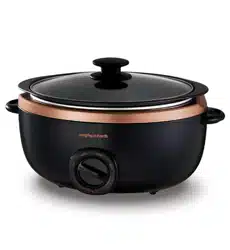Loading ...
Loading ...
Loading ...

7
Handling The Glass Lid
• When removing the Glass Lid (2), tilt so that opening faces away
from you to avoid being burned by steam.
Foods For Slow Cooking
• Most foods are suited to slow cooking methods, however there
are a few guidelines that need to be followed.
• Ensure all frozen ingredients are thoroughly defrosted prior to
cooking.
• Cut root vegetables into small, even pieces, as they take longer to
cook than meat. They can be gently sauteed for 2-3 minutes
before slow cooking. Ensure that root vegetables are always
placed at the bottom of the Cooking Pot (3) and all ingredients are
immersed in the cooking liquid.
• Trim all excess fat from meat before cooking, as the slow cooking
method does not allow fat to evaporate.
• If adapting an existing recipe from conventional cooking, you may
need to reduce the amount of liquid used. Liquid will not
evaporate from your Slow Cooker to the same extent as
conventional cooking.
• Never leave uncooked food at room temperature in your Slow
Cooker.
• Uncooked kidney beans must be soaked overnight and boiled for
at least 10 minutes to remove toxins before use in a Slow Cooker.
• Insert a meat thermometer into joints of roasts, hams or whole
chickens to ensure they are cooked to the desired temperature.
• Do not use your Slow Cooker to reheat food.
Slow Cooking Tips
• The Slow Cooker must be at least half full for best results.
• Slow cooking retains moisture. If you wish to reduce liquid,
remove the lid after cooking and turn the control to High. Reduce
the moisture by simmering for 30 to 45 minutes.
• If cooking soups, leave 5 cm gap from the rim of the Cooking Pot
(3) and the food surface to allow for simmering.
• Removing the Glass Lid (2) will allow heat to escape, reducing the
efficiency of your Slow Cooker and increasing the cooking time. If
you remove the lid to stir or add ingredients, you will need to
allow 10-15 minutes extra cooking time for each time you remove
the Glass Lid (2).
• Many things can affect how quickly a recipe will cook, including
water and fat content, initial temperature of the food and the size
of the food. Check food is properly cooked before serving.
• Many recipes will take several hours to cook. If you don’t have
time to prepare food in the morning, prepare it the night before,
storing the food in a covered container in the fridge. Transfer the
food to the Cooking Pot (3) and add boiling liquid/stock. In most
of the recipes in this book, the meat ingredients are browned first
to improve their appearance and flavour.
• If you are short on preparation time and would prefer to skip the
searing stage, simply add your meat and other ingredients into
your Slow Cooker and cover with boiling liquid/stock. You will
need to increase the recipe cooking time as follows: High setting
+1hr, Medium setting +1-2 hrs, Low Setting +2-3hrs.
• Most meat and vegetable recipes require 8-10 hours on Low, 6-8
hours on Medium or 4-6 hours on High Setting.
• Some ingredients are not suitable for slow cooking. Pasta,
seafood, milk and cream should be added towards the end of the
cooking time.
• Pieces of food cut into small pieces will cook quicker. A degree of
‘trial and error’ will be required to fully optimise the potential of
your Slow Cooker.
• All food should be covered with a liquid, gravy or sauce. In a
separate pan or jug, prepare your liquid, gravy or sauce and
completely cover the food in the Cooking Pot (3).
• When cooking joints of meat, ham, poultry etc, the size and shape
of the joint is important. Try to keep the joint in the lower 2/3 of the
pot. If necessary, cut into two pieces. Joint weight should be kept
within the maximum limit of 1kg.
• For ham and brisket fill with hot water to just cover the joint. For
beef, pork or poultry cover to 1/3 depth
Care And Cleaning
• Turn off and unplug your Slow Cooker from the mains. Allow to
cool completely before cleaning.
• Do not use metal utensils or abrasive cleaners when cleaning.
• Remove the Glass Lid (2) and Cooking Pot (3) and clean in hot
soapy water.
• Wipe the sides of the main unit with a damp cloth.
• The Glass Lid (2) and Cooking Pot (3) are
dishwasher safe.
DO NOT IMMERSE THE BASE UNIT IN WATER
Caring For The Glass Lid And Cooking Pot
• Please handle the Glass Lid (2) and Cooking Pot (3) carefully to
ensure long life.
• Avoid sudden, extreme temperature changes to the Glass Lid (2).
For example, do not place a hot lid into cold water or onto a wet
surface.
• Avoid hitting the Glass Lid (2) against any hard surfaces.
• Do not use the Glass Lid (2) if chipped, cracked or severely
scratched.
• Do not use abrasive cleansers or metal scouring pads.
• Never heat the Cooking Pot (3) when empty, when searing or
browning add the meat as soon as the oil is hot.
• Never place the Glass Lid (2) or Cooking Pot (3) under a grill, in
the oven, in a microwave or toaster oven.
• Never place lid directly on a burner or hob.
• Do not use metal utensils when searing or to stir food in the
Cooking Pot (3) as this will scratch and remove the non stick
coating. Use either wooden or silicone plastic utensils.
o
SC461016MAUS Rev1.qxp_Morphy Richards Instruction Book 20/12/2018 12:37 Page 7
Loading ...
Loading ...
Loading ...
